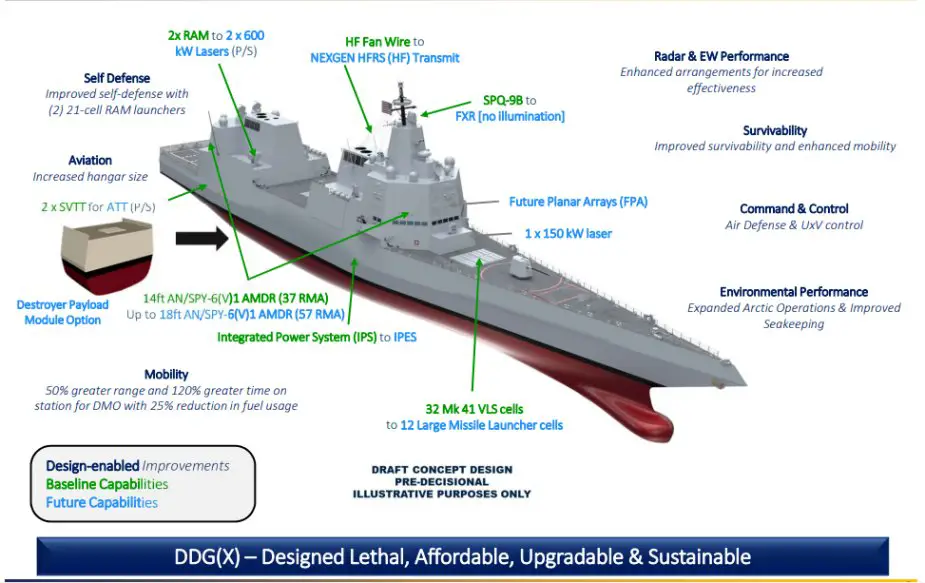The Congressional Budget Office (CBO) has been published on November 2022 to describe the Navy’s planned inventory, purchases, deliveries, and retirements of ships in its fleet for the next 30 years.
Follow Navy Recognition on Google News at this link
 Artist rendering of the future DDG(X) destroyer. (Picture source: US DoD)
Artist rendering of the future DDG(X) destroyer. (Picture source: US DoD)
In a departure from all previous shipbuilding plans, the Navy’s fiscal year 2023 shipbuilding plan provided three alternative long-range projections of its future fleet rather than one. In this report, the Congressional Budget Office analyzes the alternatives in the 2023 plan and estimates the costs of implementing each of them.
Fleet Size
If the Navy adhered to the schedule for purchases and ship retirements outlined in its 2023 plan, by 2052 the number of battle force ships would increase from 292 today to 316 under Alternative 1, 327 under Alternative 2, or 367 under Alternative 3. In all three cases, the fleet would be smaller over the next 10 years than it is today, before increasing in size.
Attack and Large Payload Submarines
According to the 2023 shipbuilding plan, after an initial decline to 46 SSNs in 2028, the SSN force would become larger and more capable than it is today.
Under Alternative 1, the Navy would buy 54 SSNs and would have 60 in the fleet by 2052. Under Alternative 2, the Navy would buy the most SSNs, purchasing 66 of them over the next 30 years. In that case, the force would reach 60 SSNs by 2045 and 69 by 2052. Under Alternative 3, the Navy would purchase 60 SSNs; its inventory would reach 60 ships by 2046 and 65 ships by 2052.
The composition of the SSN force, however, would be very different depending on which alternative was implemented. Under Alternatives 1 and 3, the Navy would invest more heavily in next-generation SSN(X) submarines, buying nearly twice as many of them as it would under Alternative 2.
In contrast, under Alternative 2, the Navy would buy more submarines overall but would continue production of the Virginia class submarines, both with and without the Virginia payload module (VPM), through 2052.
DDG(X) Next-Generation Destroyers
According to the 2023 plan, production of the next-generation class of destroyers would start in 2030, two years later than envisioned in the December 2020 plan and five years later than in the fiscal year 2020 plan.
According to Navy officials, the new DDG(X)’s combat capabilities would be equivalent or superior to those of the DDG-51 Flight III; it would also have a larger hull, substantially more power, more stealth characteristics, and a greater capacity to accommodate the installation of new weapon systems and other capabilities in the future.
In its recent shipbuilding plans, the Navy provided few details about the size the DDG(X). Previously, CBO estimated that the ship would displace 12,000 tons—about 2,000 tons more than the DDG-51 Flight III.
Now, however, the Navy has indicated that the initial design prescribes a displacement of 13,500 tons. If that is the case, then the Navy’s estimates imply that the DDG(X) would cost 10 percent more than the DDG-51 Flight III but would have a full-load displacement that is 40 percent greater.



